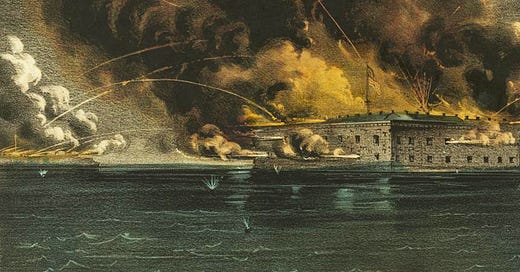A Gauntlet Tossed Upon Water
At Fort Sumter, Beauregard Took the Bait from Lincoln and the Civil War Was On

The Setup
U.S. Army Major John Anderson and his garrison of Union soldiers were holed up in Fort Sumter, smack in the entrance to Charleston Harbor and about a mile from land. It was not a comfortable existence. South Carolina considered the fort to be its property and refused to allow the North to supply the men occupying it. Food was running low. The fort was still unfinished, not all of its cannons were in working order and poor old Anderson couldn’t get any direction from President Lincoln who was too busy setting a trap for the Confederates.

Then began one of the oddest events of the Civil War.
(Believe it or not, the following are their actual words)
April 11, 1861: Headquarters, Fort Sumter
GENERAL: I have the honor to acknowledge the receipt of your communication demanding the evacuation of this fort; and to say in reply thereto that it is a demand with which I regret that my sense of honor and obligations to my government prevent my compliance. Thanking you for the fair, manly and courteous terms proposed and for the high compliment paid me, I am, General, very respectfully,
Your obedient servant
ROBERT ANDERSON, Major, United States Army, commanding
TO: Maj. Robert Anderson, Commanding
SIR: By authority of Brigadier General Beauregard, commanding he Provisional Forces of the Confederate States, we have the honor to notify you that he will open the fire of his batteries on Fort Sumter in one hour from this time. We have the honor to be, very respectfully, your obedient servants.
JAMES CHESNUT JR. Aide de Camp
STEPHEN D. LEE, Captain, C.S. Army, Aide de Camp

With those chivalrous, oh so polite and gentlemanly words the bloodiest and ugliest four-year orgy of murder, mayhem and destruction in America’s history was about to get started.
Did you find this out in school?
At 2:45 in the morning of April 11, three Confederate officers went out across a mile of dark water in an oarboat and landed on the ramp at Fort Sumter for the second time. Their mission there was to try a last-ditch effort of persuading Commander Robert Anderson to peacefully evacuate the garrison. They had taken with them two cases of claret, one case of whiskey and two boxes of cigars as gifts to the officers and men, hoping to gain favor sufficient for them to accept Beauregard’s ultimatum. But to no avail. Anderson respectfully declined.
(Ironically, Robert Anderson had been General Beauregard’s artillery instructor at West Point!)

After the second meeting, lighted by candles in a dark casemate, Anderson escorted them to the boat ramp and shook hands with each.”
“Gentlemen,” he said, “if we never meet in this world again may God grant that we may meet in the better one.”
The returning Confederates beached their boat on James Island as one of them, Colonel James Chesnut, gave the order to fire. It was 4.26 a.m. The flash was the same as lightning; blinding white and accompanied by a deafening concussion which shook the ground. The 105-pound ball of cast iron arched upward for just over a mile before falling back to earth. At a height of 150 feet above Fort Sumter it exploded, signalling cannon crews all around Charleston Harbor to open fire on the fort.

Find out some fascinating details about the surrender of Fort Sumter and meet some of the people involved. Plus get an easy plan for making some tasty grits. Become a paid subscriber and help “Eat Your History” to continue.
Keep reading with a 7-day free trial
Subscribe to Eat Your History to keep reading this post and get 7 days of free access to the full post archives.



